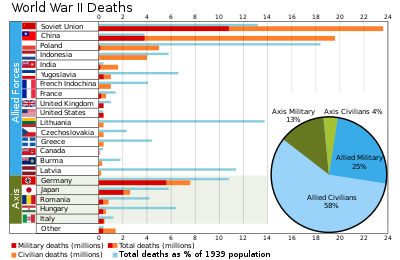
Back خسائر الحرب العالمية الثانية Arabic Жертви през Втората световна война Bulgarian Víctimes de la Segona Guerra Mundial Catalan Oběti druhé světové války Czech Tote des Zweiten Weltkrieges German Απώλειες κατά τον Β΄ Παγκόσμιο Πόλεμο Greek Kvanto de viktimoj de la dua mondmilito Esperanto Anexo:Víctimas de la Segunda Guerra Mundial Spanish Teise maailmasõja ohvrite arv Estonian تلفات جنگ جهانی دوم Persian


World War II was the deadliest military conflict in history. An estimated total of 70–85 million deaths were caused by the conflict, representing about 3% of the estimated global population of 2.3 billion in 1940.[1] Deaths directly caused by the war (including military and civilian fatalities) are estimated at 50–56 million, with an additional estimated 19–28 million deaths from war-related disease and famine. Civilian deaths totaled 50–55 million. Military deaths from all causes totaled 21–25 million, including deaths in captivity of about 5 million prisoners of war. More than half of the total number of casualties are accounted for by the dead of the Republic of China and of the Soviet Union. The following tables give a detailed country-by-country count of human losses. Statistics on the number of military wounded are included whenever available.
Recent historical scholarship has shed new light on the topic of Second World War casualties. Research in Russia since the collapse of the Soviet Union has caused a revision of estimates of Soviet World War II fatalities.[2] According to Russian government figures, USSR losses within postwar borders now stand at 26.6 million,[3][4] including 8 to 9 million due to famine and disease.[4][5][2] In August 2009 the Polish Institute of National Remembrance (IPN) researchers estimated Poland's dead at between 5.6 and 5.8 million.[6] Historian Rüdiger Overmans of the Military History Research Office (Germany) published a study in 2000 estimating the German military dead and missing at 5.3 million, including 900,000 men conscripted from outside of Germany's 1937 borders, in Austria, and in east-central Europe.[7][8] The Red Army claimed responsibility for the majority of Wehrmacht casualties during World War II.[9] The People's Republic of China puts its war dead at 20 million,[10] while the Japanese government puts its casualties due to the war at 3.1 million.[11] An estimated 7–10 million people died in the Dutch, British, French and US colonies in South and Southeast Asia, mostly from war-related famine.[12][13][14][15][16]
- ^ "International Programs – Historical Estimates of World Population – U.S. Census Bureau". 2013-03-06. Archived from the original on 2013-03-06. Retrieved 2020-03-28.
- ^ a b Geoffrey A. Hosking (2006). "Rulers and victims: the Russians in the Soviet Union". Harvard University Press. p. 242; ISBN 0-674-02178-9
- ^ Michael Ellman and S. Maksudov, Soviet Deaths in the Great Patriotic War: a note – World War II – Europe Asia Studies, July 1994.
- ^ a b Andreev EM; Darsky LE; Kharkova TL, Population dynamics: consequences of regular and irregular changes. in Demographic Trends and Patterns in the Soviet Union Before 1991. Routledge. 1993; ISBN 0415101948
- ^ Rossiiskaia Akademiia nauk. Liudskie poteri SSSR v period vtoroi mirovoi voiny: sbornik statei. Sankt-Peterburg 1995; ISBN 5-86789-023-6, pp. 124–31 (these losses are for the territory of the USSR in the borders of 1946–1991, including territories annexed in 1939–40).
- ^ Wojciech Materski and Tomasz Szarota. Polska 1939–1945. Straty osobowe i ofiary represji pod dwiema okupacjami Institute of National Remembrance (IPN), Warsaw, 2009; ISBN 978-83-7629-067-6
- ^ Overmans, Rüdiger (2000). Deutsche militärische Verluste im Zweiten Weltkrieg (in German). Oldenbourg. p. Bd. 46. ISBN 3-486-56531-1.
{{cite book}}: CS1 maint: location missing publisher (link) - ^ Overmans 2000, p. 228.
- ^ Pauwels, Jacques (2015). The Myth of the Good War (Revista ed.). Toronto: James Laurimer & Company. p. 73. ISBN 978-1459408722.
- ^ China's Anti-Japanese War Combat Operations. Guo Rugui, editor-in-chief Huang Yuzhang Jiangsu People's Publishing House, 2005; ISBN 7-214-03034-9, pp. 4–9.
- ^ Ishikida, Miki (July 13, 2005). Toward Peace: War Responsibility, Postwar Compensation, and Peace Movements and Education in Japan. iUniverse, Inc. p. 30. ISBN 978-0595350636. Retrieved March 4, 2016.
- ^ Archived copy Archived May 16, 2017, at the Wayback Machine
- ^ "The Great Vietnamese Famine of 1944-45 Revisited1944−45". 24 January 2011.
- ^ Pierre van der Eng (2008). "Food Supply in Java during War and Decolonisation, 1940–1950". Munich Personal RePEc Archive | No. 8852. pp. 35–38.
- ^ John W. Dower. War Without Mercy 1986; ISBN 0-394-75172-8, p. 296 (300,000 forced laborers)
- ^ Cite error: The named reference
Werner Gruhl p. 143-144was invoked but never defined (see the help page).